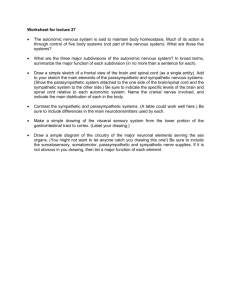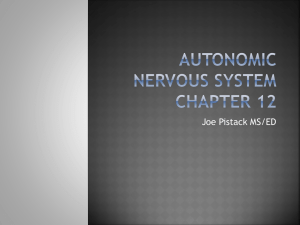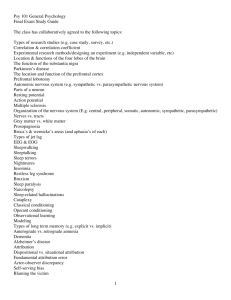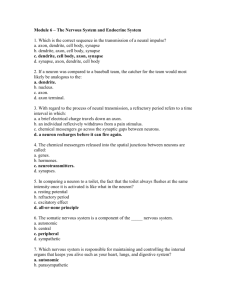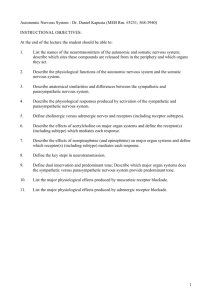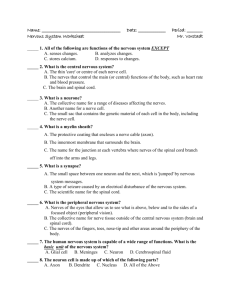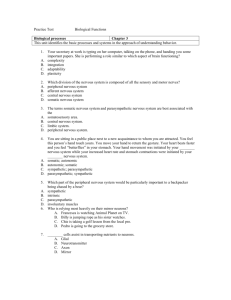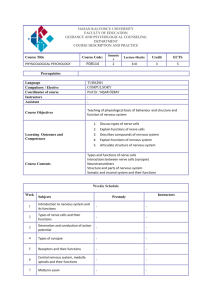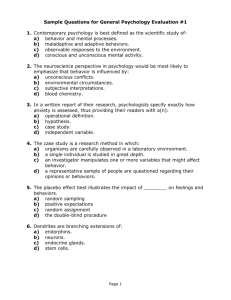test or death - The Nervous System
advertisement
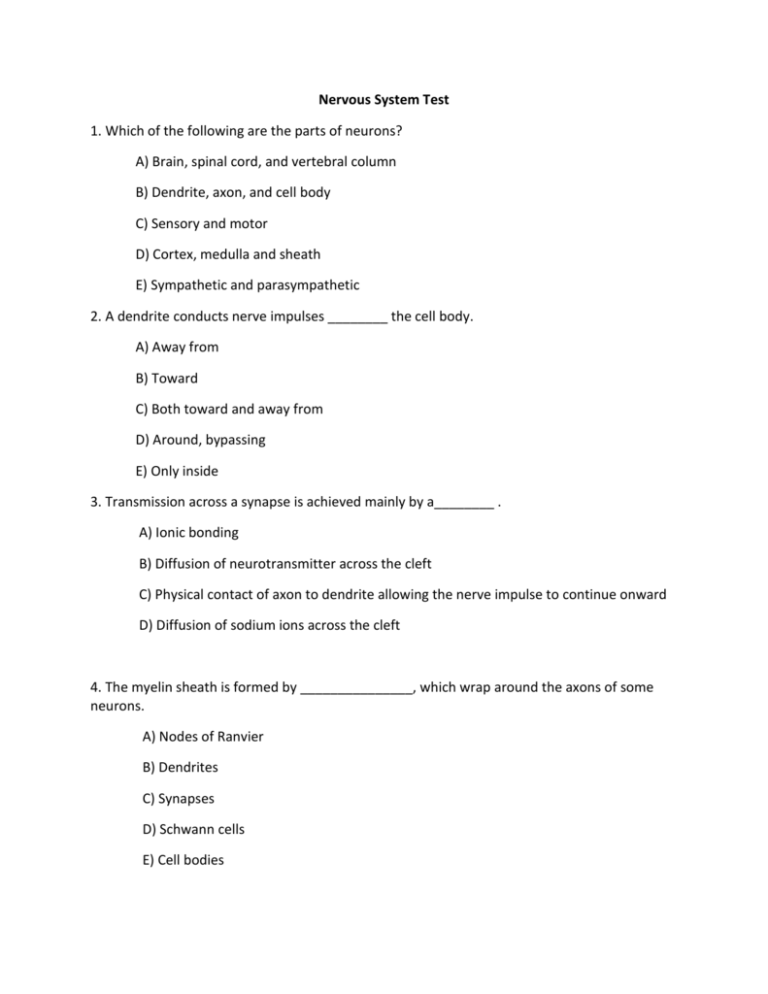
Nervous System Test 1. Which of the following are the parts of neurons? A) Brain, spinal cord, and vertebral column B) Dendrite, axon, and cell body C) Sensory and motor D) Cortex, medulla and sheath E) Sympathetic and parasympathetic 2. A dendrite conducts nerve impulses ________ the cell body. A) Away from B) Toward C) Both toward and away from D) Around, bypassing E) Only inside 3. Transmission across a synapse is achieved mainly by a________ . A) Ionic bonding B) Diffusion of neurotransmitter across the cleft C) Physical contact of axon to dendrite allowing the nerve impulse to continue onward D) Diffusion of sodium ions across the cleft 4. The myelin sheath is formed by _______________, which wrap around the axons of some neurons. A) Nodes of Ranvier B) Dendrites C) Synapses D) Schwann cells E) Cell bodies 5. The two halves of the brain, the left brain and the right brain, are NOT connected and share no communication. A) True B) False 6. During the resting potential of a neuron, which of the following is least likely to be found in large quantities inside the neuron? A) Na+ B) K+ C) Negatively charged anions D) None of the above would be found in large quantities inside the neuron 7. The brain and spinal cord are protected by membranes known as the ________. A) Nodes of Ranvier B) Meninges C) Axomembranes D) Myelin sheath 8. Higher thought processes for learning and memory are primarily in the ________. A) Medulla oblongata B) Cerebellum C) Cerebrum D) Pons 9. Cerebrospinal fluid is found only in the brain. A) True B) False 10. The central nervous system consists of the ____________. A) Combination of the sympathetic and parasympathetic nervous systems B) Brain and spinal cord C) Combined sensory and motor systems D) Cranial and spinal nerves 11. The part of the body that integrates the information it receives from all over the body in order to make decisions is called the ________. A) Peripheral nervous system B) Sympathetic nervous system C) Parasympathetic nervous system D) Central nervous system 12. Which of the following are characteristic of the sympathetic system? A) Inhibits the digestive tract B) Dilates the bronchi C) Accelerates the heartbeat D) all of the above 13. Which of the following is/are characteristic of the parasympathetic system? A) Causes the pupil to contract B) Promotes digestion of food C) Retards the heartbeat D) all of the above 14. Nerves are structures that contain many short fibers joined end-to-end. A) True B) False 15. What are the main divisions of the nervous system? A) The sensory system and the motor system B) The peripheral nervous system and central nervous system C) The dendritic and the axonal systems D) The sympathetic and parasympathetic systems 16. Excitatory signals have a/an ________ effect. A) Hyperpolarizing B) Neutral C) Depolarizing D) Positive E) Negative 17. _________ is the summing up of excitatory and inhibitory signals. A) Acting potential B) Reticular formation C) Neurotransmission D) Synapse E) Integration 18. Transmission across a synapse is achieved mainly by a________ . A) Ionic bonding B) Diffusion of neurotransmitter across the cleft C) Contact of axon to dendrite allowing the nerve impulse to continue onward D) Diffusion of sodium ions across the cleft 19. The action potential is measured in millivolts (mV) and is ranged from: A) -90mV to +20mV B) -70mV to +30mV C) -65mV to +40mV D) -30mV to +60mV 20. The action potential pattern that appears on the oscilloscope screen is caused by rapid ________. A) Polarity changes B) pH changes C) Breakdown of the membrane structure D) all of the above Essay questions 1. Explain why a person with nerve damage could lose the ability to control some skeletal muscles. 2. Explain the process the nervous system takes so that you can consciously register what you are feeling and react to it

